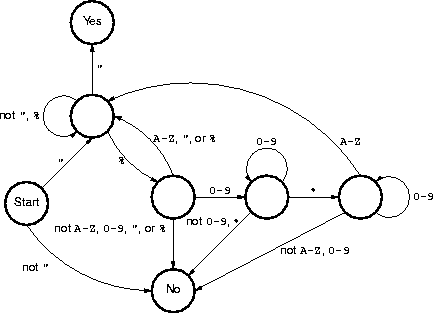A character may be any character except the per-cent character % and the
double quote ".
A format specification begins with a per-cent character, immediately followed
by an optional size specification, immediately followed by a mandatory type
specification. A type specification may be any of the characters a
through z in either case. A size specification consists of a sequence of
one or more decimal digits, followed by a period (.) followed by a
sequence of zero or more decimal digits.
An escape specification consists of the per-cent character immediately followed by a per-cent character or a double quote.
Describe an algorithm which accepts a string and determines if the entire string represents a valid format string.
This recognizer requires the input string be exactly a format string. Upper case letters represent both cases.
class point {
// blah blah blah
point & operator=(const point & p) const {
cerr << "in point=\n";
// blah blah blah
}
// blah blah blah
};
int main(void) {
point p1, p2;
// blah blah blah
p1 = p2;
// blah blah blah
}
int main(void) {
point * p1 = new point;
point * p2 = new point;
// blah blah blah
p1 = p2;
// blah blah blah
}
Your colleague has forgotten that the types T and pointer to T are two different types. Defining the assignment operator
(I've omitted the reference indicatorspoint operator=(const point p)
& for clarity) does not define the
assignment operator
point * operator=(const point * p)
we implementedknows["tristan"]["isolde"]
Explain briefly how you would use operator overloading to implement a true 2-dimensional matrix class.knows["tristan isolde"]
Do not go into details for this question, because there are a lot of them; just
briefly explain the classes you'd use and the way you'd use them to overload
operator[] to provide a 2-dimensional matrix data type.
Probably the easiest way to answer this question is to parenthesize the expression
as it would be evaluated by the compiler:knows["tristan"]["isolde"]
Let(knows["tristan"])["isolde"]
knows be a value of type Matrix. The Matrix type defines
operator[], which returns some value v (assuming no indexing errors).
This reduces the previous expression to
v["isolde"]
What can we say about this expression? First, it must return a value of the
type of the elements in Matrix. What is the type of v? It can't be
of type Matrix because that would mean the first indexing operator
Matrix::operator[]'s return type is the same as the matrix-element type,
which would require that all matrix-element types used must respond to the
indexing operator (also, it would result in infinite recursion). v's type
has to be some new type, intermediate between Matrix and the type of the
matrix elements.
Although v could be many types, two of the most natural types for v
are MatrixColumn and MatrixRow; that is, the type of the value
knows["tristan"] is a row (or a column) of the matrix indexed by
"tristan". In addition to being natural, making the intermediate type be
MatrixRow would be consistent with the definition of multi-dimensional
arrays in C++.
The classes and operator[] definitions are
class Matrix {
MatrixRow & operator[](IndexType &);
};
Class MatrixRow {
ElementType & operator[](IndexType &);
};
Matrix and MatrixRow? How are ElementType and
IndexType indicated? and so on - but the important idea is to define an
intermediate type half-way between Matrix and ElementType.
A couple of people suggested using the pair data type to represent the two index values using a single array operator:
I accepted this as an answer, but it's not really a 2-dimensional array because it doesn't treat each dimension separately, as the example given above and C++ does.ElementType Matrix::operator[](const pair<IndexType, IndexType> & p);
It is amusing to note that you can give a similar implementation by overloading the comma operator:
An example use isIndexType operator,(const IndexType & i, const IndexType & j); ElementType Matrix::operator[](const IndexType & i);
Theknows["tristan", "isolde"]
operator, would take the two index values and munge them into one for
use by operator[]; in our example, it would catenate the two indices in
order with a space between them:
As indicated by the prototype, the"tristan", "isolde" == "tristan isolde"
operator,
cannot be a member function of Matrix (why?); also the possible types for
IndexType are restricted (to what? and why?). This problem also doesn't
treat the matrix as a 2-dimensional entity.
It is even more amusing to note that we can also solve this problem by
overloading operator():
This solution has the advantage of treating the matrix as a 2-dimensional entity.MatrixRow Matrix::operator()(const IndexType & i); ElementType Matrix::operator()(const IndexType & i, const IndexType & j);
operator++
and are running into a few problems. First they tried
class C {
// blah blah blah
void operator ++ (const C & obj);
// blah blah blah
}
class C {
// blah blah blah
void operator ++ (const C & obj, int i);
// blah blah blah
}
Your colleagues' problem arises because they forgot about the magic integer
argument that differentiates between prefix operator++ and postfix
operator++. They also apparently forgot that, in a class operator
overloading, the first argument is implicit defined by the compiler and should
not be included in the argument list.
The first error occurred because the argument type is wrong: it's an argument
of type C & when it should be an argument of type int.
The second error occurred when your colleagues mis-interpreted the error message and added a second (really a third) argument to the operator definition, giving the operator too many arguments.
Their problem can be correctly resolved by giving a single actual augment of
type int:
void operator++(int);